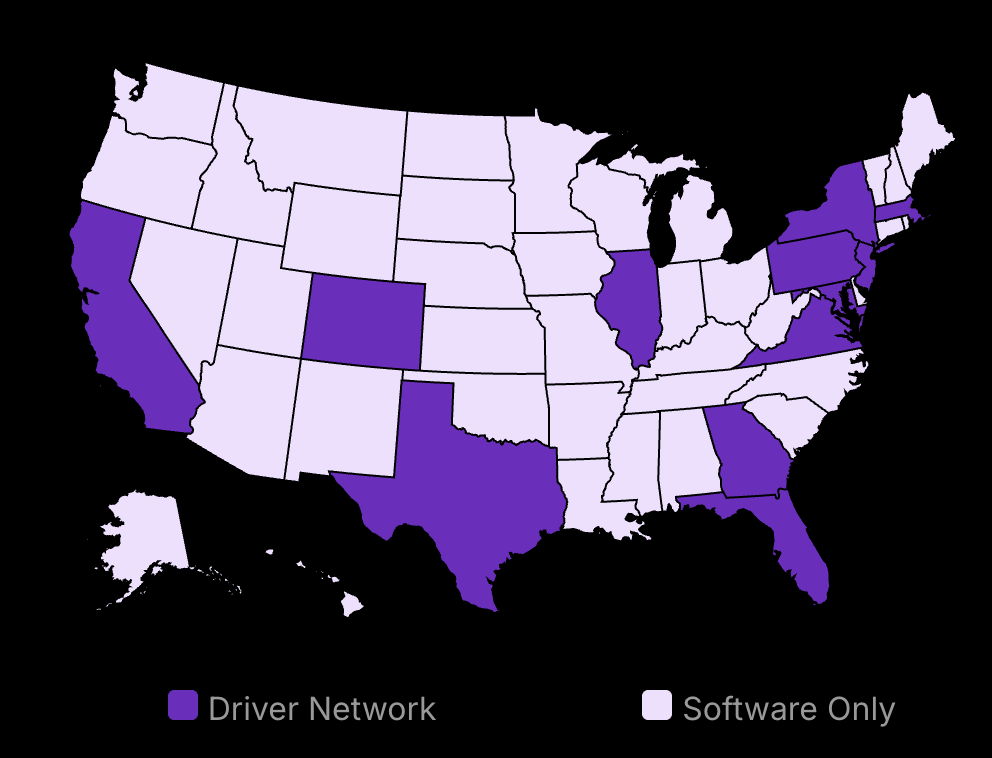The most effective print advertisements combine striking images, concise messaging, and eye catching emotional resonance to create lasting impressions. Great print advertising cuts through noise by telling complete stories in single frames. The unforgettable ones make you stop, think, and feel something—whether that’s surprise, humor, or empathy. This article breaks down the key elements of memorable print campaigns from brands like Kit Kat, Coca Cola, Volkswagen and Apple, providing great examples of how they’ve mastered the art of saying more with less. You’ll learn practical techniques to evaluate what makes print advertising truly stand out in a digital world.

Boost customer satisfaction with just a few clicks
Most-Loved Features:
- On-demand drivers
- Real-time GPS tracking
- Delivery confirmation photos
- Over 50% of customers report a smoother delivery experience
What Is The Best Advertisement For A Business?
The best print ads balance clear messaging, emotional connection, and strong ROI
Print advertising remains powerful because of its trustworthiness and tangibility
Successful print ads align perfectly with brand identity while solving customer problems
Defining Effective Advertising: Beyond Creativity
The best print advertisements for a business aren’t necessarily the most creative or visually stunning images —it’s the one that achieves specific ad aims while connecting with the target audience. At its core, effective advertising combines two critical metrics: engagement and return on investment (ROI).
Engagement measures how well a print ad captures and holds audience attention through technology, utilizing an effective concept and emotional appeal , while ROI tracks the financial returns generated relative to the campaign’s cost. The Harvard Business Review found that many brands focusing purely on creativity without strategic direction often fail to drive meaningful business results. The most successful campaigns maintain a careful balance between creative execution and strategic goals.
For businesses of all sizes, the best advertisement is one that solves a specific marketing challenge. This might be building brand awareness, launching a new product, changing consumer perceptions, or driving immediate sales. What makes an ad “best” varies dramatically based on these objectives. A small local business might need foot traffic more than brand recognition, while an established company might prioritize changing customer perceptions over immediate sales.
Key Components That Make Advertisements Work
The most effective advertisements share several fundamental components, and a prime example is the way these elements work together to create ads that not only get noticed but drive action. These design elements work together to create print ads that not only get noticed but drive action.
First, clarity of message stands as the foundation of effective advertising. The best print ads communicate their core value proposition in seconds, utilizing effective design elements to make it immediately clear what’s being offered and why it matters. This clarity extends to visual elements, words headlines, and overall concept. Apple’s print campaigns exemplify this approach—minimal text, striking visuals, and an instantly understandable message. Cluttered ads with competing messages, such as color swatches, typically underperform, regardless of how creative they might be.
Second, emotional connection transforms good print ads into great ones. Successful advertisements tap into fundamental human emotions—joy, fear, aspiration, nostalgia, or security, often enhanced by clever visuals . Research shows that emotionally resonant ads are remembered longer and drive more action than purely informational approaches. The famous Volkswagen “Think Small” campaign succeeded by embracing honesty and humility during an era when car ads typically boasted about size and power. This emotional authenticity created trust that translated to sales.
Third, strong brand alignment ensures that advertisements reinforce rather than confuse brand identity. The visual style, tone, and messaging should feel consistent with everything else the company produces. This consistency builds recognition and trust over time. Coca-Cola maintains remarkable consistency across its print advertising, ensuring that their red and white color scheme, typography, and overall feeling of happiness remain constant, like a self portrait, despite changing specific campaigns.
Finally, the most effective print ads include a clear call to action (CTA) that guides the audience toward the desired next step. Whether that’s visiting a website, making a purchase, or changing a perception, the ad features a CTA that provides direction for the emotional and intellectual engagement the ad has created.
Print Advertising That Stands The Test of Time
While digital advertising dominates discussion today, print advertising, including newspaper ads, continues to demonstrate remarkable effectiveness. Print ads benefit from higher trust levels—80% of consumers trust print ads when making purchasing decisions, and print generates a 112% return in consumer response rates.
The anatomy of memorable print campaigns
Several print campaigns, such as MBF’s breast cancer awareness campaign, serve as a brilliant example of achieving iconic status by delivering a powerful message to raise awareness and perfectly executing the principles of effective advertising. MBF’s breast cancer awareness campaign in Women’s Weekly magazine created an interactive experience that resulted in 83% notice rate and an 800% increase in screening bookings, showing how print ads can drive direct action when the message connects emotionally.
IKEA’s pregnancy test advertisement represents another groundbreaking example. This innovative print ad included an actual pregnancy test that, when used, revealed a special discount on cribs for expecting mothers. Despite limited distribution, this campaign generated global buzz and perfectly aligned with IKEA’s brand identity of practical innovation and life-stage solutions.
Volkswagen’s “Think Small” campaign remains the gold standard of a great print ad because it transformed a perceived weakness (the car’s small size) into a strength, setting a new trend during an era when American cars emphasized largeness. The honest, straightforward approach built trust while clearly communicating the practical benefits, such as a test drive, of a smaller vehicle.
What makes these print campaigns truly effective isn’t just their creativity but their strategic precision. Each addressed a specific business challenge while connecting emotionally with the audience in ways that aligned perfectly with their brand identity.
Which Advertising Approaches Deliver The Best Results?
When businesses ask “what kind of advertising is most effective,” the answer depends on their specific goals, audience, and resources. However, certain approaches consistently outperform others across different contexts.
Personalized advertising significantly outperforms generic messaging. Print ads tailored to specific audience segments generate 30% more sales than non-personalized approaches. This personalization extends beyond simply addressing someone by name—it means understanding audience needs, behaviors, and preferences, such as a breakfast sandwich then crafting messages that speak directly to these factors.
Context-relevant advertising also shows superior performance. Print ads that match the content they appear alongside see a 23% increase in memory retention and 43% higher emotional engagement. This principle applies across both print and digital channels—an outdoor equipment ad in a hiking magazine feels natural and welcome, while the same ad might feel intrusive elsewhere.
Storytelling-based approaches typically generate stronger results than purely feature-focused advertising. The most successful ads tell a compelling story that places the customer, not the product, at the center. These narratives help customers see themselves using the product or service and experiencing its benefits, making abstract advantages concrete and personal.
While digital channels offer sophisticated targeting capabilities, print advertising maintains unique strengths that make it highly effective for certain goals that resonate with our daily lives . The physical nature of print creates a tangible connection that digital channels can’t replicate. Print ads typically receive more focused attention, with readers spending more time engaging with content compared to digital formats where skipping and scrolling behaviors are common.
The question of effectiveness ultimately depends on how well the chosen advertising approach addresses the specific business challenge while resonating with the target audience. The best advertisements, regardless of medium, connect with customers on both practical and emotional levels while remaining authentic to the brand’s core identity.
Iconic Print Advertising Campaigns
Iconic print campaigns combine simplicity, emotional connection, and clear brand messaging
The most memorable ads break industry conventions and remain relevant for decades
Print campaigns with lasting impact tell stories that transcend their products
The DNA of Iconic Print Advertisement and Campaigns
What separates good print ads from truly legendary ones? The answer lies in three key elements: creative innovation, strategic thinking, and cultural impact. Iconic print advertisement and campaigns don’t just sell products—they shift perceptions, start conversations, and sometimes even change society. These ads stand out because they challenge expectations while delivering crystal-clear messages that stick in the public consciousness.
The most memorable print campaigns share certain traits. First, they embrace simplicity. The best print ads, often considered a creative ad, communicate complex ideas through minimal text and striking visuals. Take Corona’s beach advertisements with just a beach scene and beer bottle—no explanation needed. Second, iconic campaigns find honest connections with their audience. They identify real human needs or tensions and address them authentically. Third, memorable campaigns take creative risks. They break industry norms and stand out precisely because they don’t look like typical advertising.
Print advertising’s physical nature gives it significant advantages over digital formats. Research from Temple University found that print, including classified ads, activates brain areas associated with value and desire more strongly than digital ads. A 2023 study by the Data & Marketing Association showed that 58% of consumers trust print advertising more than any other medium. This combination of physical presence and consumer trust creates powerful brand recall—people remember print ads they saw decades ago, while yesterday’s digital ads often fade from memory immediately.
Case Studies: Campaigns That Defined Advertising
Volkswagen “Think Small” (1959)
The story of how a small German car transformed American advertising starts with honesty. In 1959, when U.S. automakers pushed bigger vehicles with flashy claims, Doyle Dane Bernbach took a different approach for Volkswagen. Their “Think Small” campaign featured a tiny Beetle in vast white space with understated copy about the car’s limitations and benefits. This campaign didn’t just sell cars—it changed advertising forever.
“Think Small” worked because it embraced authenticity when competitors relied on exaggeration. The campaign acknowledged the Beetle’s unusual appearance and size, turning perceived weaknesses into strengths. It spoke to consumers as intelligent people who could appreciate practicality over flash. This honest approach built tremendous trust with consumers, much like the admiration for a van gogh painting .
Beyond its immediate success in helping VW grow its U.S. market share, the campaign established a new standard for creative advertising. It showed that wit, honesty, and clean design could outperform loud claims and busy visuals, even in the realm of digital marketing . More than 60 years later, advertising professionals still study this campaign as the turning point when creative innovation became a competitive advantage.
Apple “Think Different” (1997-2002)

When Steve Jobs returned to Apple in 1997, the company faced financial trouble and an identity crisis. The “Think Different” campaign didn’t showcase products at all—instead, it featured black and white portraits of iconic figures like Einstein, Gandhi, and Amelia Earhart. The campaign’s message was powerful: Apple stood for creativity, innovation, and challenging the status quo.
What made this campaign extraordinary was its focus on values rather than products. Instead of competing on technical specifications, Apple positioned itself as a brand that shared the vision of history’s greatest thinkers and creators. This approach created a deep emotional connection with audiences who wanted to see themselves as creative and forward-thinking.
The impact was remarkable. Apple’s revenue rose over 20% to $8 billion in the year following the campaign’s launch. Beyond financial metrics, “Think Different” reestablished Apple’s identity and prepared the market for revolutionary products like the iPod and iPhone. This campaign, much like a successful magazine ad, shows how print advertising can transform a company’s future by changing public perception of what the brand represents.
Why These Campaigns Stand the Test of Time
The most memorable print campaigns share a critical quality: they transcend their products and connect to larger human truths. Volkswagen’s “Think Small” wasn’t just about a car—it celebrated honesty and rejected artificial status symbols. Apple’s “Think Different” wasn’t selling computers as much as a creative identity. These campaigns reach beyond functional benefits to address how people see themselves, their world, and even their inner child.
Another key factor in lasting impact is cultural timing, much like what is seen in iconic expressionist paintings . Iconic campaigns, especially from car brands, often arrive at moments when society is ready for new perspectives. The Economist’s “White out of Red” campaign launched in 1988 with clever, minimalist copy targeting business professionals. The campaign drove a 65% increase in circulation and 95% rise in subscriptions for print ads during its run from 1988-2001. Its success reflected changing attitudes about business intelligence and self-education during a time of global economic transformation.
Technical excellence also contributes to longevity. Ads that demonstrate perfect alignment between concept, copy, and design become teaching tools for future generations. Absolut Vodka’s bottle-shaped campaign ran for decades with over 1,500 creative variations while maintaining instant brand recognition. This remarkable consistency, combined with endless creative reinvention, made the campaign a master class in brand building. Even now, marketing students study these campaigns to understand the fundamentals of effective communication.
Print and Magazine Ad Campaigns to Give an Important Message To Customers
Print ads remain powerful tools for business owners seeking to make a lasting impact. The best print ads blend clear messaging, emotional connection, and strong design to create something truly special. From Volkswagen’s “Think Small” to Apple’s “Think Different,” these campaigns show how print can cut through noise and speak directly to customers.
What makes these ads unforgettable isn’t just creativity—it’s their ability to connect with people on a human level. Whether through humor, nostalgia, or empathy, the emotional core of great print advertising stays with us long after we’ve turned the page.
For business owners and ad agency professionals, the message is clear at first glance: print advertising still deserves a place in your marketing strategy. Its tangible nature creates a different kind of trust and engagement than digital media alone can provide. The most successful businesses understand this balance. To truly maximize your local impact, consider a multi-channel approach that complements your print campaigns. Combining traditional print ads with targeted community efforts can amplify your reach and engagement. For excellent strategies on how to effectively promote your business in your local area, check out these 8 powerful ways to promote your business locally in 2025.
Maximizing your advertising efforts means not only investing in print but also exploring innovative local marketing tactics. These strategies can help ensure your brand gains the spotlight it deserves within your community and beyond. For more detailed insights and actionable tips, discover how to promote your business locally with proven methods, blending both traditional and modern approaches effectively.
As you create your next print campaign, remember the lessons from these iconic examples. It is best to focus on clarity, emotional resonance, and visual impact. With these elements in place, your ad won’t just be seen—it will be remembered, shared, and acted upon.



























